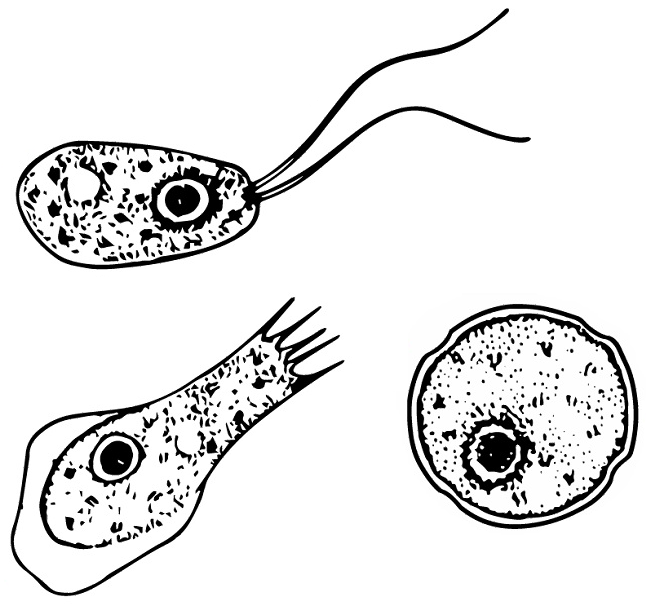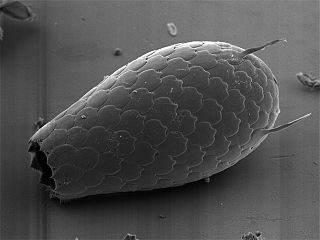
A flagellate is a cell or organism with one or more whip-like appendages called flagella. The word flagellate also describes a particular construction characteristic of many prokaryotes and eukaryotes and their means of motion. The term presently does not imply any specific relationship or classification of the organisms that possess flagellae. However, the term "flagellate" is included in other terms which are more formally characterized.

The Percolozoa are a group of colourless, non-photosynthetic Excavata, including many that can transform between amoeboid, flagellate, and cyst stages.

The family Vampyrellidae is a subgroup of the order Aconchulinida within the phylum Cercozoa. Based on molecular sequence data, the family currently comprises the genus Vampyrella, and maybe several other vampyrellid amoebae. The cells are naked and characterised by radiating, filose Pseudopodia and an orange colouration of the main cell body.

Heliozoa, commonly known as sun-animalcules, are microbial eukaryotes (protists) with stiff arms (axopodia) radiating from their spherical bodies, which are responsible for their common name. The axopodia are microtubule-supported projections from the amoeboid cell body, and are variously used for capturing food, sensation, movement, and attachment. They are similar to Radiolaria, but they are distinguished from them by lacking central capsules and other complex skeletal elements, although some produce simple scales and spines. They may be found in both freshwater and marine environments.

The Cercozoa are a group of single-celled eukaryotes. They lack shared morphological characteristics at the microscopic level, being defined by molecular phylogenies of rRNA and actin or polyubiquitin. They are the natural predators of many species of microbacteria and Archea.

The Rhizaria are a species-rich supergroup of mostly unicellular eukaryotes. Except from the Chlorarachniophyte and three species in the genus Paulinella in the phylum Cercozoa, they are all non-photosynthethic, but many foraminifera and radiolaria have a symbiotic relationship with unicellular algae. A multicellular form, Guttulinopsis vulgaris, a cellular slime mold, has also been described. This supergroup was proposed by Cavalier-Smith in 2002. Being described mainly from rDNA sequences, they vary considerably in form, having no clear morphological distinctive characters (synapomorphies), but for the most part they are amoeboids with filose, reticulose, or microtubule-supported pseudopods. Many produce shells or skeletons, which may be quite complex in structure, and these make up the vast majority of protozoan fossils. Nearly all have mitochondria with tubular cristae.

The Phaeodarea, or Phaeodaria, are a group of amoeboid Cercozoa. They are traditionally considered radiolarians, but in molecular trees do not appear to be close relatives of the other groups, and are instead placed among the Cercozoa. They are distinguished by the structure of their central capsule and by the presence of a phaeodium, an aggregate of waste particles within the cell.

The euglyphids are a prominent group of filose amoebae that produce shells or tests from siliceous scales, plates, and sometimes spines. These elements are created within the cell and then assembled on its surface in a more or less regular arrangement, giving the test a textured appearance. There is a single opening for the long slender pseudopods, which capture food and pull the cell across the substrate.
Gymnophryidae is a small family of amoeboids that lack shells and produce thin, reticulose pseudopods. These contain microtubules and have a granular appearance, owing to the presence of extrusomes, but are distinct from the pseudopods of Foraminifera. They are included among the Cercozoa, but differ from other cercozoans in having mitochondria with flat cristae, rather than tubular cristae.

Monadofilosa is a grouping of Cercozoa. These organisms are single-celled amoeboid protists.

Imbricatea is a class of Rhizaria characterised by silica scales. It is sometimes described as "Imbricatea/Silicofilosea", due to the similarity of those two groupings. Imbricatea is divided into the orders Euglyphida and Thaumatomonadida.
Cryomonadida is a group of heterotrophic Rhizaria, that belong to the Cercozoa.
Thaumatomonas is a genus within Imbricatea of the phylum Cercozoa.
Paracercomonas is a genus of rhizaria.

The Apusomonadida are a group of protozoan zooflagellates that glide on surfaces, and mostly consume prokaryotes. They are of particular evolutionary interest because they appear to be the sister group to the Opisthokonts, the clade as that includes both animals and fungi. Together with the Breviatea, these form the Obazoa clade.
Katabia is a genus of cercozoa.
Eocercomonas is a genus of cercozoa.

Kraken is a genus of amoebae within the Cercozoa, containing the sole species Kraken carinae. These amoebae are characterized by a small round cell body and a network of thin and very long filopodia that can reach up to a mm in diameter. Kraken amoebae feed on bacteria and live in freshwater and soil systems.
Endohelea is a proposed clade of eukaryotes that are related to Archaeplastida and the SAR supergroup.
Neocercomonas is a protist genus of the order Cercomonadida. It consists of single-celled bacteriophagous organisms that usually live on or nearby terrestrial plants, both above and belowground. Species are biflagellate and may grow up to 60 micrometers long, with a trailing tail-like mass of protoplasm at their posterior end and a pair of roots connecting their posterior flagellum to the cytoskeleton.










